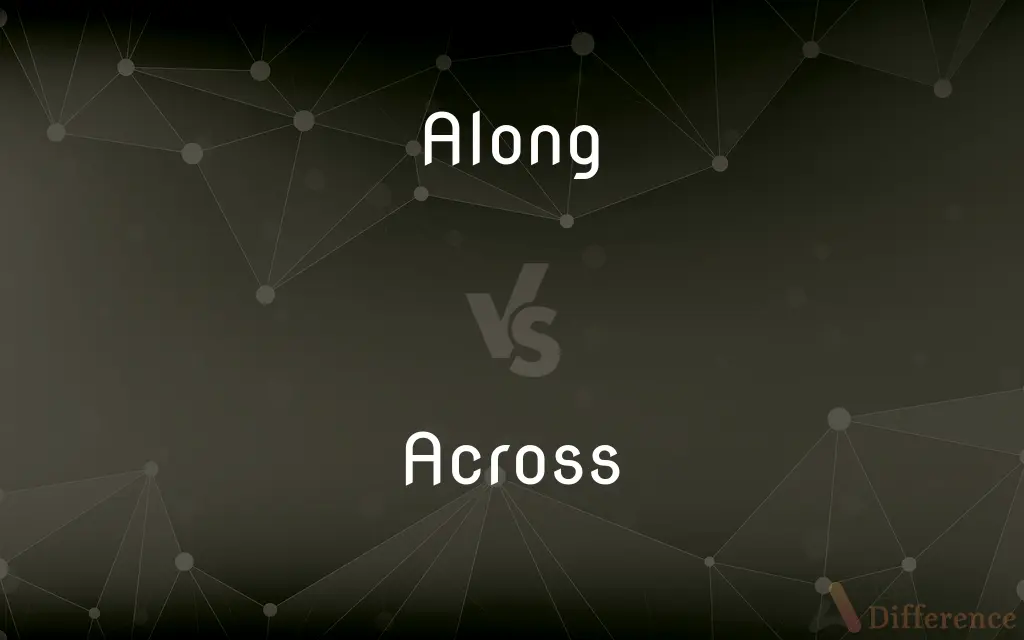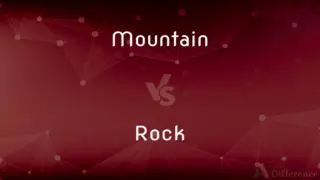Along vs. Across — What's the Difference?
By Tayyaba Rehman & Maham Liaqat — Updated on March 14, 2024
"Along" refers to movement in a continuous line following the length of something, while "across" indicates movement from one side to the other over or through something.

Difference Between Along and Across
Table of Contents
ADVERTISEMENT
Key Differences
"Along" is used to describe movement or placement that extends continuously in a line next to or parallel with something. It often implies a journey or movement that follows the length of a particular path or area. For instance, walking along a river means moving parallel to the river's course. On the other hand, "across" suggests a traversal from one side to another, implying a crossing over or through. Walking across a bridge means moving from one end of the bridge to the other, crossing over the space it spans.
When "along" is used, it conveys a sense of progression or movement that is linear and extended, often without a specific starting or ending point being mentioned. It highlights the continuity of movement or presence along a certain line or path. Whereas, "across" typically involves a clear starting point and destination, emphasizing the act of crossing a boundary or intervening space to get from one side to the other.
"Along" is often associated with actions that occur within the boundaries or alongside the length of something, such as a road, path, or object. This preposition suggests a proximity or parallelism to the object in question. In contrast, "across" is used when the action involves overcoming an obstacle, gap, or area, suggesting a more direct or transversal movement.
In terms of orientation, "along" implies a longitudinal alignment with the object or area, where the movement or location is extended in the same direction as the length of the object. "Across," however, implies a transverse orientation, where the movement cuts across the usual or longest dimension of an area or object.
The choice between "along" and "across" depends on the intended meaning of the speaker or writer, with "along" emphasizing a linear, parallel movement or presence and "across" focusing on the concept of crossing over or through an area or surface.
ADVERTISEMENT
Comparison Chart
Definition
Movement or presence in a continuous line next to something.
Movement from one side to the other over something.
Connotation
Implies following the length of something in a parallel manner.
Indicates crossing over or through an area.
Orientation
Longitudinal, following the length.
Transverse, cutting across the usual dimension.
Movement
Linear and extended, without necessarily crossing over.
Directly from one point to another, crossing an area.
Usage
Used to describe proximity or parallelism.
Used to describe overcoming an obstacle or gap.
Compare with Definitions
Along
Moving or extending in a direction on or beside something.
We hiked along the trail that winds through the forest.
Across
From one side to the other over something.
The bridge allows you to walk across the river.
Along
Following the edge of something.
He ran his finger along the rim of the glass.
Across
Through an area or space.
She spread the map across the table to show us the route.
Along
In a line parallel to the length of something.
The children walked along the beach, collecting shells.
Across
Spanning or extending over.
The road runs straight across the desert.
Along
During a part of something.
Along the journey, we encountered many interesting sights.
Across
In a crossing pattern over something.
The fabric featured a pattern of lines running across it.
Along
Situated on or near something.
There are several cafes along this street.
Across
Across a barrier or dividing line.
The new policy has caused debate across all levels of society.
Along
Over the length of
Walked along the path.
Across
On, at, or from the other side of
Across the street.
Along
On a line or course parallel and close to; continuously beside
Rowed along the shore.
The trees along the avenue.
Across
So as to cross; through
Drew lines across the paper.
Along
In accordance with
The committee split along party lines over the issue.
Across
From one side of to the other
A bridge across a river.
Along
Forward; onward
We drove along, admiring the view. Farther along, we passed a hitchhiker.
Across
Into contact with
Came across my old roommate.
Along
As company
Bring your friend along.
Across
From one side to the other
The footbridge swayed when I ran across.
Along
In accompaniment or association; together
Packed an atlas along with other books. See Usage Note at together.
Across
On or to the opposite side
We came across by ferry.
Along
With one; at hand
Luckily, I had my camera along. Our guests should be along soon.
Across
Crosswise; crossed.
Along
(Informal) Advanced to some degree
My father is getting along in years.
Across
In such a manner as to be comprehensible, acceptable, or successful
Put our idea across.
Get a message across.
Along
By the length of; in a line with the length of; lengthwise next to.
Across
Being in a crossed position
Seated with arms across.
Along
In a line with, with a progressive motion on; onward on; forward on.
Across
To, toward, or from the far side of (something that lies between two points of interest).
We rowed across the river.
Fortunately, there was a bridge across the river.
He came across the street to meet me.
Along
In company; together.
John played the piano and everyone sang along.
Across
On the opposite side of (something that lies between two points of interest).
That store is across the street.
Along
Onward, forward, with progressive action.
Don't stop here. Just move along.
Across
Across from: on the opposite side, relative to something that lies between, from (a point of interest).
Along
By the length; in a line with the length; lengthwise.
Some laid along . . . on spokes of wheels are hung.
Across
From one side to the other within (a space being traversed).
The meteor streaked across the sky.
He walked across the room.
Could you slide that across the table to me, please?
Along
In a line, or with a progressive motion; onward; forward.
We will go along by the king's highway.
He struck with his o'ertaking wings,And chased us south along.
Across
At or near the far end of (a space).
Along
In company; together.
He to England shall along with you.
Across
Spanning.
This poetry speaks across the centuries.
Along
By the length of, as distinguished from across.
The kine . . . went along the highway.
Across
Throughout.
All across the country, voters were communicating their representatives.
Along
Now heard only in the prep. phrase along of.
Across
So as to intersect or pass through or over at an angle.
Lay the top stick across the bottom one.
She had straps fastened across the conduit every six feet.
Along
With a forward motion;
We drove along admiring the view
The horse trotted along at a steady pace
The circus traveled on to the next city
Move along
March on
Across
In possession of full, up-to-date information about; abreast of.
Along
In accompaniment or as a companion;
His little sister came along to the movies
I brought my camera along
Working along with his father
Across
From one side to the other.
She helped the blind man across;
The river is half a mile across
Along
To a more advanced state;
The work is moving along
Well along in their research
Hurrying their education along
Getting along in years
Across
On the other side.
If we sail off at noon, when will we be across?
Along
In addition (usually followed by `with');
We sent them food and some clothing went along in the package
Along with the package came a bill
Consider the advantages along with the disadvantages
Across
In a particular direction.
He leaned across for a book.
Along
In line with a length or direction (often followed by `by' or `beside');
Pass the word along
Ran along beside me
Cottages along by the river
Across
(crosswords) Horizontally.
I got stuck on 4 across.
Across
A word that runs horizontally in the completed puzzle grid or its associated clue.
I solved all of the acrosses, but then got stuck on 3 down.
Across
From side to side; athwart; crosswise, or in a direction opposed to the length; quite over; as, a bridge laid across a river.
Across
From side to side; crosswise; as, with arms folded across.
Across
Obliquely; athwart; amiss; awry.
The squint-eyed Pharisees look across at all the actions of Christ.
Across
Placed crosswise;
Spoken with a straight face but crossed fingers
Crossed forks
Seated with arms across
Across
To the opposite side;
The football field was 300 feet across
Across
In such a manner as to be understood and accepted;
She cannot get her ideas across
Across
Transversely;
The marble slabs were cut across
Common Curiosities
What does "along" indicate in a sentence?
"Along" indicates movement or presence that extends continuously next to or parallel with something.
What does "across" imply?
"Across" implies movement from one side to another, crossing over or through a specific area or object.
How does "along" differ from "across" in terms of movement?
"Along" suggests a linear, parallel movement, while "across" suggests crossing over an area or space.
Can "along" and "across" be used interchangeably?
No, they convey different spatial relationships and orientations, making them not interchangeable.
What situations are best described using "across"?
"Across" is best for situations involving crossing from one side to another over or through something.
What kind of actions does "along" typically describe?
"Along" describes actions that occur in a line next to or in parallel with something, often without crossing over.
Is "along" related to the length or width of something?
"Along" is related to the length, suggesting movement or presence extending in the same direction as the length.
Can "along" imply a specific direction of movement?
Yes, it implies a direction that is linear and follows the length of something, but it does not specify starting or ending points.
What does "across" reveal about the orientation of movement?
"Across" reveals a transverse orientation, indicating a movement that cuts across the normal length.
What does "across" signify in terms of barriers or gaps?
"Across" signifies overcoming or crossing over barriers, gaps, or spaces, moving from one point to another.
Share Your Discovery

Previous Comparison
Tofu vs. Paneer
Next Comparison
Mountain vs. RockAuthor Spotlight
Written by
Tayyaba RehmanTayyaba Rehman is a distinguished writer, currently serving as a primary contributor to askdifference.com. As a researcher in semantics and etymology, Tayyaba's passion for the complexity of languages and their distinctions has found a perfect home on the platform. Tayyaba delves into the intricacies of language, distinguishing between commonly confused words and phrases, thereby providing clarity for readers worldwide.
Co-written by
Maham Liaqat













































